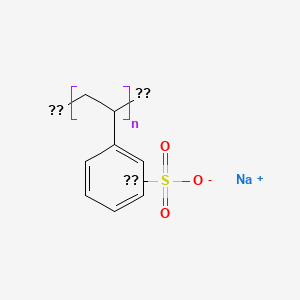Attribution Statement: LactMed is a registered trademark of the U.S. Department of Health and Human Services.
NCBI Bookshelf. A service of the National Library of Medicine, National Institutes of Health.
Drugs and Lactation Database (LactMed®) [Internet]. Bethesda (MD): National Institute of Child Health and Human Development; 2006-.
CASRN: 9080-79-9

Drug Levels and Effects
Summary of Use during Lactation
Because sodium polystyrene sulfonate is not orally absorbed, it is unlikely to reach the breastmilk or adversely affect the breastfed infant after maternal administration. No special precautions are required.
A suspension of sodium polystyrene sulfonate has been added directly to breastmilk to lower the potassium concentration of milk for use in infants with renal impairment. In addition to lowering average potassium content by 65%, the calcium content of breastmilk was reduced by 84%.[1] Infants given either expressed breastmilk, formula or a combination of both had their average serum potassium levels decreased by 24% from 6.3 to 4.8 mEq/L. Serum calcium and creatinine also decreased slightly. The infants had no clinically noticeable side effects.[2] Addition of large amounts of sodium polystyrene sulfonate to artificial formula also lowers the calcium, copper, manganese, phosphorus, sulfur and zinc concentrations; whereas the iron, sodium and sulfur content of formulas are increased.[3] Similar changes might occur with breastmilk.
Effects in Breastfed Infants
Relevant published information was not found as of the revision date.
Effects on Lactation and Breastmilk
Relevant published information was not found as of the revision date.
Alternate Drugs to Consider
References
- 1.
- Bonnet L, Goudable J, Accominotti M, et al. Nephrologie. 1997;18:287–9. [Effect of polystyrene sulfonate resins on milk ionic concentration] [PubMed: 9496569]
- 2.
- Thompson K, Flynn J, Okamura D, et al. Pretreatment of formula or expressed breast milk with sodium polystyrene sulfonate (Kayexalate(R)) as a treatment for hyperkalemia in infants with acute or chronic renal insufficiency. J Ren Nutr. 2013;23:333–9. [PubMed: 23707305]
- 3.
- Taylor JM, Oladitan L, Carlson S, et al. Renal formulas pretreated with medications alters the nutrient profile. Pediatr Nephrol. 2015;30:1815–23. [PMC free article: PMC4572699] [PubMed: 25930981]
Substance Identification
Substance Name
Sodium Polystyrene Sulfonate
CAS Registry Number
9080-79-9
Disclaimer: Information presented in this database is not meant as a substitute for professional judgment. You should consult your healthcare provider for breastfeeding advice related to your particular situation. The U.S. government does not warrant or assume any liability or responsibility for the accuracy or completeness of the information on this Site.
- User and Medical Advice Disclaimer
- Drugs and Lactation Database (LactMed) - Record Format
- LactMed - Database Creation and Peer Review Process
- Fact Sheet. Drugs and Lactation Database (LactMed)
- Drugs and Lactation Database (LactMed) - Glossary
- LactMed Selected References
- Drugs and Lactation Database (LactMed) - About Dietary Supplements
- Breastfeeding Links
- PMCPubMed Central citations
- PubChem SubstanceRelated PubChem Substances
- PubMedLinks to PubMed
- Review Sevelamer.[Drugs and Lactation Database (...]Review Sevelamer.. Drugs and Lactation Database (LactMed®). 2006
- Pretreatment of formula or expressed breast milk with sodium polystyrene sulfonate (Kayexalate(®)) as a treatment for hyperkalemia in infants with acute or chronic renal insufficiency.[J Ren Nutr. 2013]Pretreatment of formula or expressed breast milk with sodium polystyrene sulfonate (Kayexalate(®)) as a treatment for hyperkalemia in infants with acute or chronic renal insufficiency.Thompson K, Flynn J, Okamura D, Zhou L. J Ren Nutr. 2013 Sep; 23(5):333-9. Epub 2013 May 23.
- Renal formulas pretreated with medications alters the nutrient profile.[Pediatr Nephrol. 2015]Renal formulas pretreated with medications alters the nutrient profile.Taylor JM, Oladitan L, Carlson S, Hamilton-Reeves JM. Pediatr Nephrol. 2015 Oct; 30(10):1815-23. Epub 2015 May 1.
- Sodium polystyrene sulfonate used to reduce the potassium content of a high-protein enteral formula: a quantitative analysis.[JPEN J Parenter Enteral Nutr. ...]Sodium polystyrene sulfonate used to reduce the potassium content of a high-protein enteral formula: a quantitative analysis.Rivard AL, Raup SM, Beilman GJ. JPEN J Parenter Enteral Nutr. 2004 Mar-Apr; 28(2):76-8.
- Review Lithium.[Drugs and Lactation Database (...]Review Lithium.. Drugs and Lactation Database (LactMed®). 2006
- Sodium Polystyrene Sulfonate - Drugs and Lactation Database (LactMed®)Sodium Polystyrene Sulfonate - Drugs and Lactation Database (LactMed®)
Your browsing activity is empty.
Activity recording is turned off.
See more...
